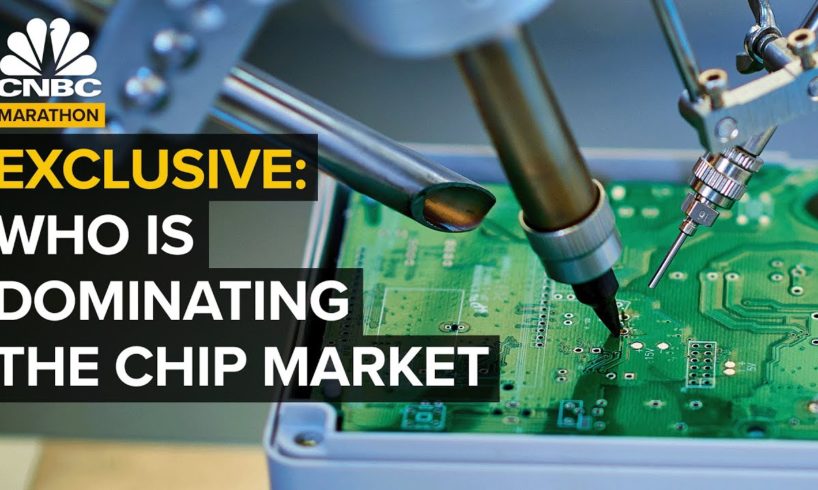
CNBC Marathon got an exclusive look at how the world makes the now all important processing chips at ASML, TSMC and Intel.
Tour inside ASML’s cleanrooms to see how these $200 million EUV systems print minuscule designs on advanced microchips using exploding molten tin, the flattest surface in the world, and light so narrow it’s absorbed by air.
Taiwan Semiconductor Manufacturing Company makes 24% of all the world’s chips, and 92% of the most advanced ones found in today’s iPhones, fighter jets and supercomputers. Now TSMC is building America’s first 5-nanometer fabrication plant, hoping to reverse a decades-long trend of the U.S. losing chip manufacturing to Asia. CNBC got an exclusive tour of the $12 billion fab that will start production in 2024.
And for decades, Intel was the leading maker of the world’s most advanced chips. Intel’s history is interwoven with that of Silicon Valley, credited with the invention of RAM and microprocessors, the building blocks of modern computing. Now Intel has fallen behind. But its new CEO, Pat Gelsinger, has a bold plan to catch up to Samsung and TSMC by 2025, by building new chip fabrication plants in the U.S., Europe and Israel totaling more than $44 billion. CNBC got an exclusive tour at the fab expansion outside Portland, Oregon, that’s set to open early next year.
CNBC Marathon brings together the best of CNBC’s chip coverage and examines how this competitive, lucrative and vital industry is changing.
Chapters:
00:00 Introduction
00:39 Inside ASML, the company that all advanced chipmakers rely on (Published Mar. 2022)
19:10 Exclusive look inside the secretive Taiwan chip giant TSMC (Published Oct. 2021)
36:47 Inside Intel’s bold $26 billion U.S. plan to regain chip dominance (Published Nov. 2021)
» Subscribe to CNBC: https://cnb.cx/SubscribeCNBC
» Subscribe to CNBC TV: https://cnb.cx/SubscribeCNBCtelevision
About CNBC: From ‘Wall Street’ to ‘Main Street’ to award winning original documentaries and Reality TV series, CNBC has you covered. Experience special sneak peeks of your favorite shows, exclusive video and more.
Connect with CNBC News Online
Get the latest news: https://www.cnbc.com/
Follow CNBC on LinkedIn: https://cnb.cx/LinkedInCNBC
Follow CNBC News on Facebook: https://cnb.cx/LikeCNBC
Follow CNBC News on Twitter: https://cnb.cx/FollowCNBC
Follow CNBC News on Instagram: https://cnb.cx/InstagramCNBC
#CNBC
How ASML, TSMC And Intel Dominate The Chip Market | CNBC Marathon
source







I already own shares of Tattooed Chefs and Kairos Minerals, and I'll buy some Corsair as well. Sure, I don't mind having these equities sit around for a few years, but I'd also like to appreciate short-term profitable investments that could, say, turn $100K into $250K.
👍 great stuff
very Insightful points and explanations….thank you so much CNBC for indepth analysis…
made my notes too for all the 3 companies….
Thanks CNBC for this informative documentary. All countries should partner rather than ostracize each other to achieve even greater heights for humanity.
If we just put our frankly counterproductive hence idiotic global bickering aside, man would be conquering Mars by now. Taiwan has the know how, the Dutch have the machines, the US the designs, the Chinese the money, the Jaoanese make everything else required from photoresists (95%), to Nikkon and Canon being the only logical competitors to ASMC. But then, we have to wall off entire industries from others coz they're 'strategic' and the others have a different system of governance, frankly unnecessary and idiotic
Greatttttttt
The worst thing is trust in a socialist Comunista Country,like CHINA. US. Make the Big mistake hope open the eyes, i think is to litle to late hope lock down China can't be trust no at Any more.
we need this to track criminals
make the city safer for children
Which comes first? EUV or chips?
The chip creaters protecting the chip by dressing properly, but when it reaches to Biden' hand he doesn't care about it. 😅
The US does not like competition..interfering in the markets.
40:25 since when did Intel invented RAM?
My answer? It's PLA Taiwan (aka China) and the relocated Silicon Valley in Texas; moved from California.
As a Dutchman, proud of ASML and don't think any other company will overlap them.
31:33 "Our Customers want us in the US – the US Government wants us here" – TRANSLATION – If you don't build a USA factory right away the USA military decide to bring its military home and not defend the straits of Taiwan …
The cost of a new chip fab has been growing FASTER than any one product market.
These costs are going up so fast that only by collecting products from MANY markets (as TSMC does) can you afford to build a new, larger, and more advanced chip fab.
Intel arrogantly tried to enter MANY new markets from 2000-2015 and FAILED every time, including attempting to become a cellphone chipset-maker TWICE in that time period. They were trying to earn more money to build a 7nm fab (& smaller). Their arrogance wasted valuable money which helped them to fall behind in 2017.
24:00 AMD became completely fabless in 2012 (selling off its last ownership stake in Global Foundries); Qualcomm has been fabless since its founding in 1989;
Broadcom has been fabless since its founding in 1991.
10:42 I'm not overly impressed because I don't know what country you're in, Michael Labelle! Maybe you are in Luxembourg? That would not be as impressive. What if you were in Russia? Now THAT would be impressive !!
EUV = Extreme UltraViolet (a very high-frequency wavelength of light = smaller details).
The EUV machine is basically a photo-printer using ultraviolet light.
And instead of printing 1 (b/w) layer or 3-layers (red, blue, green) of image, they print up to ~100 layers.
7:00 They use traditional ideas from silk screen printing to print really, really tiny pictures onto silicon.
Often they print onto a layer of metal or silicon, then in a developer step the non-printed areas are etched away, often by simple acids which avoid the EUV-exposed areas (the EUV strengthens a material you want to keep). Then a new layer of metal or silicon is added and the process repeats. Sometimes instead of just printing & removing metal, they print, remove metal, then send hot "doping materials" through the printed picture to change properties of the silicon wafer below, making it a "better semiconductor", then they etch away the rest of the metal, and repeat. Starting in the 1960's, companies were literally using photographic enlargers to print integrated-circuit chips, in 5-10 steps, and making chips & printing photographs was not terribly different.
A second factory on it's way in the USA. Taiwan have clearly displayed who and what they want to be a part of.
I make huge profits on my investment since i started trading with a professional broker Mrs Silvia Morgan, her trading strategy are top notch coupled with the little commission she charges on her trade. Thanks so much ma'am ❤️
ASML is great but they are assuming that the manufacturing semiconductors process does not have a big revolution. There might be big change on 3 nm manufacturing in 5 years time that may reduce the dependence on such an expensive machine.
I like it that the program challenges the achievability of Intel's goals. (Unlike foolish China news that assume goals are fait accompli.) At the same time, I wish there's something here for me to be hopeful about. The naysayers are raining on the parade. I was hoping for a parade. The rain can come later.
Making Chip is one thing, But, the CHIP market where the CUSTOMERS buying and consuming such are is China and countries in Asia. The truth hurts …… You can keep all the chips to yourselves at your basements.
When transfer of technology from Taiwan is done, Taiwan will b useless…financial loss from China & from Tsmc… Taiwan will suffered heavily n will cry back to its motherland!
….but not for long……world is changing…….there is nothing too big not to fall . everybody will start to build their chips
Surely this is simply American piracy. The strongarming of TMSC to arizona not only to steal and control the technology but when they manufacture a war with China to disallow China the capture of this critical technology.
It is not TSMC want to move to USA, it is that USA government orders Taiwan government to ask TSMC to build six fabrics in the USA. In terms of business, its gross profit in Taiwan is 60%, but in the USA, it is only 15%.
We didn't need them 20 years ago, we don't need them now.